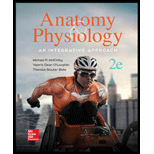
Anatomy & Physiology: An Integrative Approach
2nd Edition
ISBN: 9780078024283
Author: Michael McKinley Dr., Valerie O'Loughlin, Theresa Bidle
Publisher: McGraw-Hill Education
expand_more
expand_more
format_list_bulleted
Concept explainers
Question
Chapter 18.3, Problem 11WDYL
Summary Introduction
To determine:
The main function of an erythrocyte and in what ways an erythrocyte is designed to carry out its function efficiently.
Concept introduction:
Blood is a connective tissue, which flows from the heart through arteries and veins to all body parts. Whole blood consists of two elements - formed elements and plasma. Erythrocytes, leukocytes and platelets are the formed elements of blood. Erythrocytes are the main component of formed element of blood, which is formed by the process of erythropoiesis.
Expert Solution & Answer
Want to see the full answer?
Check out a sample textbook solution
Students have asked these similar questions
What is the main function of an erythrocyte, and in what ways is an erythrocyte designed to efficiently carry out its function?
What does an erythrocyte gain by the loss of its nucleus and organelles? What three cellular processes can it no longer engage in due to the loss of its (a) nucleus and (b) mitochondria?
What connective tissue cell shares functional and structural features with a basophilic leucocyte?
Chapter 18 Solutions
Anatomy & Physiology: An Integrative Approach
Ch. 18.1 - Prob. 1WDYLCh. 18.1 - How does blood help regulate body temperature and...Ch. 18.1 - Will blood be able to properly carry out its...Ch. 18.1 - Prob. 4WDYLCh. 18.1 - Prob. 5WDYLCh. 18.2 - Prob. 6WDYLCh. 18.2 - Prob. 7WDYLCh. 18.2 - Prob. 8WDYLCh. 18.3 - What are the two main types of precursor cells for...Ch. 18.3 - Prob. 11WDYL
Ch. 18.3 - Prob. 12WDYLCh. 18.3 - Prob. 13WDYLCh. 18.3 - Prob. 14WDYLCh. 18.3 - Prob. 15WDYLCh. 18.3 - Prob. 16WDYLCh. 18.3 - Describe the process of erythropoiesis, beginning...Ch. 18.4 - Prob. 17WDYLCh. 18.4 - Prob. 18WDYLCh. 18.4 - Prob. 19WDYLCh. 18.4 - Prob. 20WDYLCh. 18.4 - At what point in blood loss is the sympathetic...Ch. 18.4 - Prob. 22WDYLCh. 18.5 - Prob. 23WDYLCh. 18.5 - Prob. 24WDYLCh. 18 - Prob. 1DYKBCh. 18 - _____ 2. Which type of leukocyte increases during...Ch. 18 - Prob. 3DYKBCh. 18 - Prob. 4DYKBCh. 18 - Prob. 5DYKBCh. 18 - Prob. 6DYKBCh. 18 - Prob. 7DYKBCh. 18 - _____ 8. During the recycling of components...Ch. 18 - _____ 9. The extrinsic pathway of coagulation is...Ch. 18 - _____ 10. A clot is best described as a. an...Ch. 18 - How does blood help regulate body temperature?Ch. 18 - What are alpha- and beta-globulins? What do they...Ch. 18 - When blood is centrifuged, a thin, whitish-gray...Ch. 18 - What is the shape of an erythrocyte, and why is...Ch. 18 - How are respiratory gases (oxygen and carbon...Ch. 18 - What are the anatomic characteristics of each type...Ch. 18 - How do the functions of basophils differ from...Ch. 18 - Briefly describe the origin, structure, and...Ch. 18 - Prob. 19DYKBCh. 18 - Describe the three phases of hemostasis, and list...Ch. 18 - Use the following paragraph to answer questions...Ch. 18 - Prob. 2CALCh. 18 - Which sequence or pathway best describes the...Ch. 18 - Prob. 4CALCh. 18 - Prob. 5CALCh. 18 - While taking a clinical laboratory class, Marilyn...Ch. 18 - Abby is a nurse on duty in a hospital emergency...Ch. 18 - Prob. 3CSL
Knowledge Booster
Learn more about
Need a deep-dive on the concept behind this application? Look no further. Learn more about this topic, biology and related others by exploring similar questions and additional content below.Similar questions
- What is the shape of an erythrocyte, and why is this shapeadvantageous to its function?arrow_forwardWhy is blood considered a connective tissue? What is hematopoiesis? What are the stages and sites of hematopoiesis? What are the features of a normal erythrocyte?arrow_forwardWhat is most and least numerous in leukocytes, erythroytes, and platelets?arrow_forward
- If the life span of an erythrocyte is 120 days, how many times a year would a sickle cell patient need to be given a blood transfusion to ensure a unit of healthy erythrocytes at any given time?arrow_forwardWhat is the functional significance of the shape of an erythrocyte?arrow_forwardWhat is erythropoiesis? Describe in detail how the negative feedback system regulates the process of erythropoiesis?arrow_forward
arrow_back_ios
SEE MORE QUESTIONS
arrow_forward_ios
Recommended textbooks for you
 Human Biology (MindTap Course List)BiologyISBN:9781305112100Author:Cecie Starr, Beverly McMillanPublisher:Cengage Learning
Human Biology (MindTap Course List)BiologyISBN:9781305112100Author:Cecie Starr, Beverly McMillanPublisher:Cengage Learning

Human Biology (MindTap Course List)
Biology
ISBN:9781305112100
Author:Cecie Starr, Beverly McMillan
Publisher:Cengage Learning
The Cell Cycle and its Regulation; Author: Professor Dave Explains;https://www.youtube.com/watch?v=eqJqhA8HSJ0;License: Standard YouTube License, CC-BY
Cell Division - Mitosis and Meiosis - GCSE Biology (9-1); Author: Mr Exham Biology;https://www.youtube.com/watch?v=w7vp_uRA8kw;License: Standard YouTube License, CC-BY